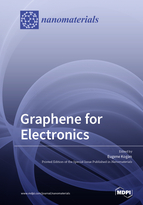Graphene for Electronics
A special issue of Nanomaterials (ISSN 2079-4991). This special issue belongs to the section "2D and Carbon Nanomaterials".
Deadline for manuscript submissions: closed (30 June 2022) | Viewed by 25285
Special Issue Editor
Interests: graphene; kondo effect; renormalization and scaling
Special Issues, Collections and Topics in MDPI journals
Special Issue Information
Dear Colleagues,
Graphene is an allotrope of carbon consisting of a single layer of atoms arranged in a two-dimensional (2D) honeycomb lattice. Graphene’s unique properties of thinness and conductivity have led to global research into its applications as a semiconductor. With the ability to well conduct electricity at room temperature, graphene semiconductors could easily be implemented into the existing semiconductor technologies and, in some cases, successfully compete with the traditional ones, such as silicon. Research has already shown that graphene chips are much faster than existing ones made from silicon. The world’s smallest transistor was manufactured using graphene. Flexible, wearable electronics may take advantage of graphene’s mechanical properties, as well as its conductivity, to create bendable touch screens for phones and tablets, for example.
On the other hand, the physics of graphene and graphene-based systems has inspired the application (and development) of many advanced theoretical methods, including those outside the scope of traditional condensed matter physics. Graphene thus turned into the favorite benchmark of theorists. Fundamental studies went hand in hand with the applied ones and, in some cases, the former even opened doors to possible applications.
This Special Issue of Nanomaterials will attempt to cover recent studies, both theoretical and experimental, that advance our understanding of graphene and may be relevant to graphene electronics. This includes (but is not limited to) studies of the processing, modification, and characterization of graphene and other 2D layered materials, studies of the mechanical, transport, magnetic, and optical properties of graphene, and studies of graphene-based electronic devices and structures.
Prof. Dr. Eugene Kogan
Guest Editor
Manuscript Submission Information
Manuscripts should be submitted online at www.mdpi.com by registering and logging in to this website. Once you are registered, click here to go to the submission form. Manuscripts can be submitted until the deadline. All submissions that pass pre-check are peer-reviewed. Accepted papers will be published continuously in the journal (as soon as accepted) and will be listed together on the special issue website. Research articles, review articles as well as short communications are invited. For planned papers, a title and short abstract (about 100 words) can be sent to the Editorial Office for announcement on this website.
Submitted manuscripts should not have been published previously, nor be under consideration for publication elsewhere (except conference proceedings papers). All manuscripts are thoroughly refereed through a single-blind peer-review process. A guide for authors and other relevant information for submission of manuscripts is available on the Instructions for Authors page. Nanomaterials is an international peer-reviewed open access semimonthly journal published by MDPI.
Please visit the Instructions for Authors page before submitting a manuscript. The Article Processing Charge (APC) for publication in this open access journal is 2900 CHF (Swiss Francs). Submitted papers should be well formatted and use good English. Authors may use MDPI's English editing service prior to publication or during author revisions.
Keywords
- graphene
- electronic devices and structures
- processing, modification, and characterization of graphene
- graphene doping
- transport properties of graphene
- magnetic properties of graphene
- optical properties of graphene







